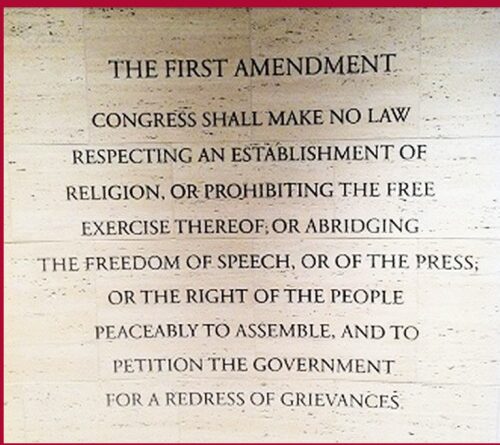Trump Challenges Supreme Court with Flag Burning Order
In 1989, the highest judicial body in the U.S., the Supreme Court, pronounced that the act of setting the American flag ablaze was a form of expression safeguarded by the First Amendment. Fast forward to August 2025, then President of the United States, Donald Trump enacted an executive order known as ‘Prosecuting Burning of the American Flag.’ Through this executive order, an attempt was made to open a legal avenue to bring charges against any individual found guilty of this act, including the withdrawal and cancellation of visas for non-U.S. residents.
It is worth noting that this executive order stood in stark contradiction to the 1989 Supreme Court ruling, which deemed flag burning as a form of free expression, preserved by the First Amendment. Interestingly, this executive order didn’t stipulate a specific punishment for those found guilty of flag desecration. Rather, Trump’s request for an annual imprisonment for anyone accused of burning the flag seems to be derived from his personal sentiment, expressed at the time of signing the order.
Delving back into history, the notable Supreme Court case Texas v. Johnson in 1989 asserted the burning of the American flag as a type of free speech protected under the First Amendment rights. The executive order aimed at ‘Prosecuting Burning of the American Flag’ was inked by President Donald Trump on August 25, 2025. While signing the executive order, Trump proclaimed, ‘If you burn a flag, you get one year in jail, no early exits, no nothing.’
Although the underlying objective of the executive order was to impose penalties on flag desecration, it failed to specify any concrete punitive measures. The legality of Trump’s executive order is a separate issue of considerable contention and is beyond the scope of our discussion here.
The case of Texas v. Johnson began brewing in 1968, amidst the upheaval of the Vietnam War and the ensuing protests that convulsed the nation. The U.S. Congress passed the Flag Protection Act that year, imposing a ban on the desecration of the national flag. In a turn of events in 1984, a man named Gregory Lee Johnson, in a move to voice opposition against the policies of President Ronald Reagan, set an American flag ablaze in front of the Dallas City Hall.
Johnson was apprehended under a Texas law forbidding the desecration of any venerated object, leading to his subsequent conviction and a fine of $2,000 alongside a one-year imprisonment. Contesting the ruling, Johnson made an appeal, the reverberations of which echoed all the way up to the Supreme Court.
The Supreme Court, through a narrow 5-4 ruling, decided in favor of Johnson, proclaiming that burning the flag was protected under the First Amendment as an expression of free speech. This landmark judgement overturned the previously upheld state and federal laws prohibiting flag desecration.
Following this, the Congress initiated several endeavors to amend the constitution to render flag desecration an illegal act. Trump’s stance on making flag desecration unlawful dates back to as early as November 2016, a testament to his long-standing opposition to the act.
Justification of the executive order appears to be a challenging task, notwithstanding the presently more conservative-leaning Supreme Court compared to the jury of the 1980s. The executive order signed by Trump offered as cause that the act of flag burning ‘may incite violence and riot’, a rationale previously rebutted by the Supreme Court in the original Texas v. Johnson case.
Nonetheless, the issued executive order mandated the U.S. attorney general to ‘vigorously prosecute those who violate our laws in ways that involve desecrating the American Flag’ and result in ‘harm unrelated to expression.’ The order loosely defined such acts as ‘violent crimes; hate crimes; and crimes against property and the peace, along with conspiracies and attempts to violate, and aiding and abetting others to violate, such laws.’
Interestingly, the executive order did not extensively elaborate on ‘other violations of Americans’ civil rights.’ It further empowered the secretary of state, the attorney general and the secretary of homeland security, providing them with the authority to ‘deny, prohibit, terminate, or revoke visas, residence permits, naturalization proceedings, and other immigration benefits, or seek removal from the United States,’ targeting noncitizens who partake in flag burning.
In essence, the potential consequences of the act of flag burning had been broadened to encompass the denial of immigration benefits, including potential removal from the U.S. for non-citizens, providing substantial additional powers to key government officials. However, the lack of specificity around the terms used, like ‘harm unrelated to expression,’ presented challenges to straightforward application and interpretation.
Beyond the individual consequences, the executive order symbolized an attempt at the executive level to redefine and restrict what fell under the constitutionally protected right of free expression. It brought into sharp focus the balance between safeguarding individual rights and the protection of national symbols and guiding principles.
Despite the intentions behind the executive order, it presented a distinct departure from existing legal precedent set by the Supreme Court. This resulted in a potential legal standoff, as constitutional protections under the First Amendment came into conflict with executive laws aimed at safeguarding national symbols.
Throughout this tale, it’s vividly clear that the interpretation and boundary of expression and its protection under the First Amendment have been subjected to voracious debate and shifting perspectives over the decades.



